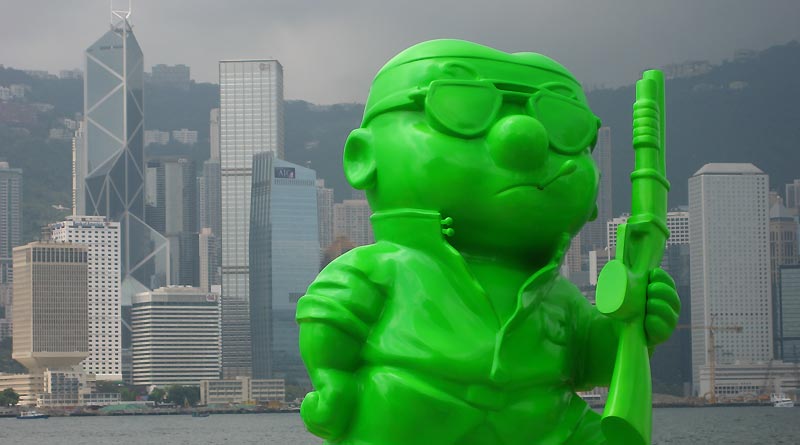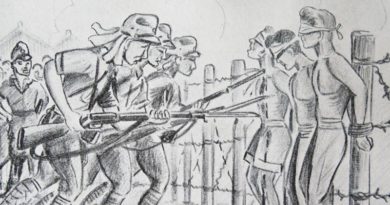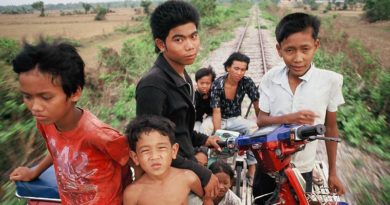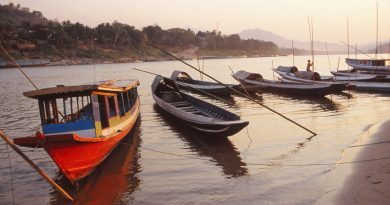Hong Kong in 48 hours
Monday, 3.50pm: Flight NZ38 drops through the clouds, revealing towering apartment blocks crowded around the fringes of a rugged island. The airport’s so big I have to catch a train just to get to baggage reclaim — but, unlike Heathrow, it’s clean, spacious and easy to navigate.
4.30pm: I find out the fast train to the city costs HK$100 (NZ$16); take a double-decker bus instead for one third the price. Great views as the highway island-hops to the city via a series of giant suspension bridges and plunges into Kowloon’s chaotic streets.

6.10pm: I pick a cheap guest house in the crumbling Mirador Mansions, on Kowloon’s main drag and next door to the infamous backpacker ghetto Chungking Mansions. It’s more of a 16-storey slum than a mansion; the first room I’m shown is windowless and so small I can only lie down in the foetal position — lesson No. 1 on the value of space in Hong Kong.
6.15pm: I take a triple room instead, which has a window and a view of the neon-lit street 13 floors below. Even the triple room is so small it’d be hard work getting three people in at once. However, it’s spotless and even the air-con works. I’m just mystified by the tap above my pillow.
7pm: I stroll down to the waterfront, ignoring the hawkers of fake Rolexes. I’m gobsmacked by the skyline of Hong Kong Island across the water — it’s like Manhattan with mountains.
7.20pm: I discover one of Hong Kong’s great bargains — the ferry between Kowloon and Hong Kong Island costs just HK$1.70 (30c), or a few cents more to perch on the upper deck. The view of the city lights across the water is sublime. As the ferry pulls in, it’s hit by the wake of a passing ship and lurches violently. A gaggle of schoolgirls is flicked off the gangway and lands squealing on the deck.
9.30pm: I wander to the Temple St night market, several blocks of glaring neon, novelty ties, clothes, tourist tat and fortune tellers. Everywhere people are tucking into mountains of food — but, somehow, the only fat people you see are Westerners.
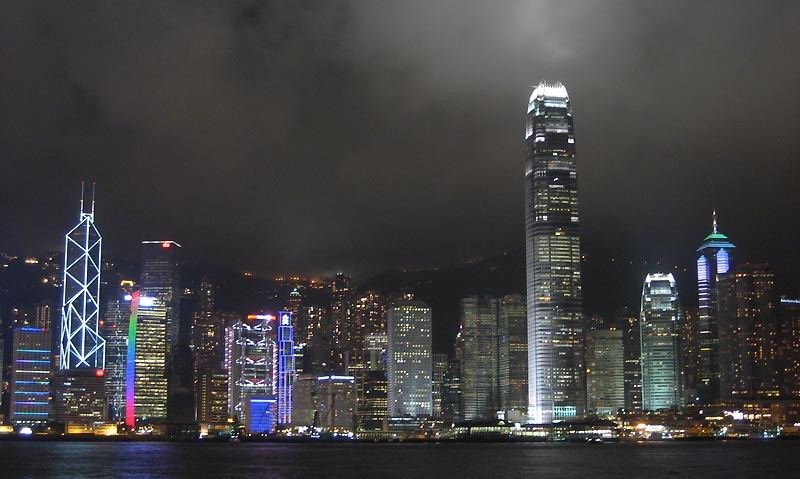
11.10pm: As I head back to the ‘Mansions’ I’m puzzled by the nice ladies offering me reflexology sessions. If they’re selling foot massages how come they’re offering to come back to my room for HK$250 an hour?
Tuesday, 9.30am: I sleep right through the alarm and wake up late; I blame the jet lag. Hit my head on the tap as I get up.
9.45am: Give up waiting for the lift and walk down 13 storeys of stairs, past shrines and smoking incense, laundry draped over bamboo poles, betel juice splatters on the walls, and wrinkled old women sweeping the corridors.
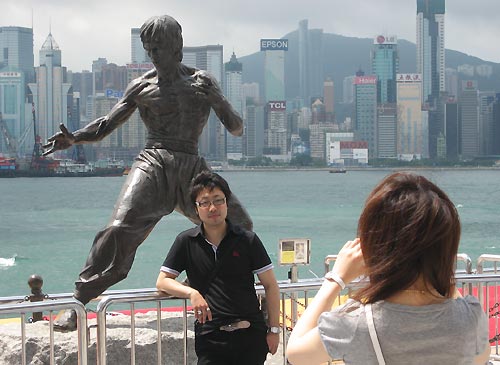
10am: I take a picnic breakfast (ice coffee and a chocolate bun that looks like a UFO rendered in dough) to the waterfront Avenue of the Stars, Hong Kong’s equivalent of Hollywood’s Walk of Fame. I watch as crowds of Chinese tourists try out Jackie Chan’s handprint for size or pose in front of Bruce Lee’s statue. I’m still amazed by the skyline, the helicopters buzzing from hotel roofs, and the endless procession of barges, ferries and fishing boats. One tiny boat is bravely weaving between the freighters as the fishermen cast out their nets.
10.50am: The sun breaks through the cloud. The temperature soars from the merely sweltering to borderline intolerable. Regret not packing shorts.
11.30am: I catch a ferry back to Hong Kong Island. An elevated walkway to the city takes me high above bustling streets from one air-conditioned shopping mall to another. The shopping is possibly outstanding, but I wouldn’t know. However, I can report the public toilets are free, spotless, and manned by uniformed attendants handing out individual towels.
12 noon: I take a peek inside architect Norman Foster’s acclaimed HSBC headquarters, a modern-day cathedral to banking with a 10-storey atrium. It was apparently the world’s most expensive building when it opened in 1985. When I try exploring further a security guard sends me back downstairs, firmly but with exquisite politeness.
1.05pm: I take the Central to Mid-Levels escalator. “So whoopdie-doo,” I hear you say — but this is no ordinary escalator. Each morning it takes tens of thousands of commuters 800m from the apartment blocks crowding Mt Victoria’s slopes down to the CBD; every day at 10.20am it reverses direction.
1.15pm: I hop off at Hollywood Rd, Hong Kong’s antiques strip. It turns out to be a bit of a tourist trap, but I also stumble on a bustling market offering mystery fruit, live fish, meat, and traditional cafes with vast lunchtime queues spilling from the doors. I squeeze next to four ladies at a cafe and, finding the menu is Chinese only, I order by pointing at someone else’s noodle soup and get almost what I want. I congratulate myself for doing well with the chopsticks — until a waiter rushes over with a fork and napkin, grave concern etched on his face.
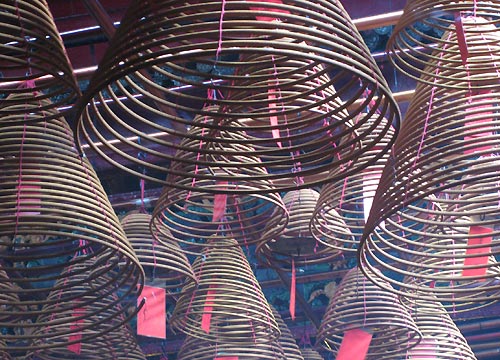
2pm: I Visit Man Mo Temple. The temple is surrounded by highrises but inside it’s another world, the air thick with smoke from hundreds of incense coils suspended from the ceiling.
2.45pm: I head back to the escalator, which then zig-zags between a forest of soaring apartment blocks. Wander down to the botanical gardens via a series of walkways and flyovers, like a pedestrian-only Spaghetti Junction.
3.30pm: I visit another architectural marvel, the 70-storey Bank of China. I ask if I can check out the view and — despite my by now dishevelled appearance — security guards point me to the ear-popping, high-speed lift.
4.15pm: I hop on to the Peak Tram, a funicular railway that climbs 1.4km up Victoria Peak. In places the track climbs by almost 30 degrees; I try not to think about what would happen if the cable snaps. I watch as the city’s skyscrapers drop away beside the rails.
4.30pm: The passengers are disgorged into Peak Tower, the inevitable shopping centre with a viewing deck charging HK$20. I find that the view from a free lookout two minutes’ walk away is just as stunning, even with the mist swirling around. The cool breeze is a relief after the stickiness of the city; I take a siesta of sorts, and walk part of a 3km trail that loops round the peak. With dusk approaching the forest comes alive with birds, frogs and insects.
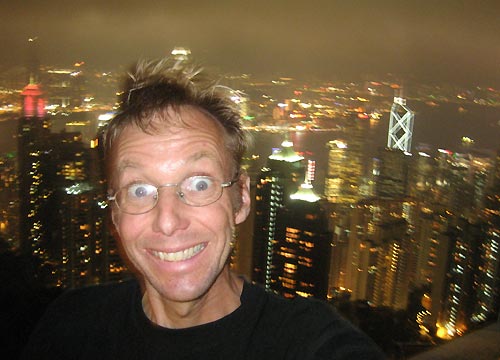
7.30pm: I find a supermarket among the Peak’s glitzy restaurants and buy a couple of beers to savour at the lookout as the city lights come on — the high point of my stay in Hong Kong, in every sense.
8.35pm: Take a bus, then the ferry back to Kowloon.
11pm: I wander back to the night market and find a table at a busy outdoor restaurant. I go for the fried dried seafood with chilli, cashews and a mystery vegetable (NZ$9). Superb.
11.10pm: I find the restaurant also employs beer girls — pretty young women whose only job is to bring you more beer. Proof, in case you still needed it, that this is a highly civilised country. Alas, my beer girl claims to be shy and won’t be in a photo. Instead I make friends with Yomu, a lovely lad visiting from Hunan Province.
Wednesday, 8.30am: Breakfast aboard the ferry to Hong Kong Island (samosas from a tiny Indian stall), and a last look at that glorious skyline.
9.15am: I arrive at Two IFC, one of the world’s tallest buildings. The girl at the desk tells me the viewing deck doesn’t open until 10am, and suggests I visit the mall. As much as I loathe shopping I take her advice and cool off in the air conditioning.
10.02am: A high-speed lift flings me to the 55th floor. Nice that it’s free, but no view’s quite the same through a thick layer of glass. Besides, the observation level is a good 100m shy of the top floor.
10.30am: I catch a ferry to Mui Wo on Lantau Island. The one-hour crossing costs just $2; you can pay double that to be sealed inside a cabin, but I’d rather be on the open deck, lashed by spray and squalls. Lantau is home to a giant bronze Buddha on a mountain peak; conveniently, it’s also home to the airport.
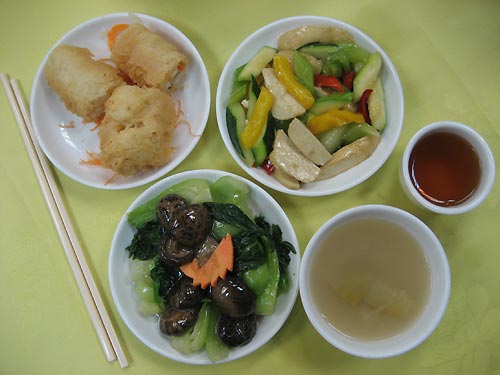
12.20pm: I arrive at Po Lin Monastery after a winding bus trip into the hills; climb 260 steps into the mist to a giant Buddha I can’t see. I do see, however, see a crystal reliquary containing a sliver of bone from, apparently, the real Buddha. I cap off the visit with a pilgrim’s meal served with a dose of grammatically suspect Buddhist wisdom: “Don’t afraid of becoming poor, what we have got in our live is not decided by us, but our fate.”
1.45pm: I consider taking a bus around the island to the airport, but seeing it’s just 7km in a direct line from the monastery, I take a gamble and walk cross-country. I pray I don’t get lost in the mist and miss my flight, but the track is clearly marked as it drops through lush forest echoing with chants from another monastery. I pass grey-robed monks digging vegetable patches and iridescent blue butterflies the size of sparrows.
2.55pm: I emerge from the bush on the edge of a small town of huge apartment blocks. Within minutes a bus turns up and whisks me the last few kilometres to the airport.
3.30pm: Check-in. I vow to come back to Hong Kong — but next time I’ll make sure I have more than 48 hours.

